Heat-treated gblack diamondsh appeared widely in the gem market several years ago. Magnification test using a optical microscope is generally effective to identify them, but we propose the effectiveness of photoluminescence analysis, which works effectively to detect HPHT treatment. Background and gemmological features of the heat-treated black diamonds are introduced here.
|
|
| Photo.1:Black diamonds set in a jewellery. |
Black diamonds have commonly been used as one of jewellery materials since several years ago, and a series of melee stones are often set in a designed piece.
There are three types known as the gblackh diamond: 1. natural colour diamond; 2. irradiation treated diamond; 3. heat-treated under high temperature.
In the late 1990fs, one avant-garde jewellery designer started using natural black diamond, which had been used for industrial purpose till then, in combination with colourless diamond (Photo-1). This fresh idea was immediately received by other designers and it became rage of the times. The cause of natural black colour is black inclusion such as graphite or iron minerals, and the body colour of the stone is not black.
Growing demand for black diamond required securing of sufficient material, and it made substitute with artificial irradiation come appear. This material is obtained mainly by irradiating neutron in an atomic reactor, and although it appears black, it is actually deep green. This gives the material character that tend to show (blue-) green colour under strong transmitted light, and it is not difficult to distinguish this from natural colour stones (see 2000, Sep. issue).
A new type of gblackh diamond, described as 3. above, appeared in the new century. The stones were originally natural diamonds of very poor quality single crystals or white to grey polycrystalline crystals (Photo-2), which turned black colour by being heated in high temperature (HT) under reducing atmosphere (i.e., under condition of little oxygen) to graphitise partly(Photo-3).
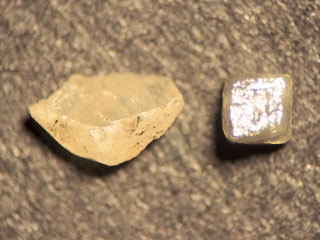 |
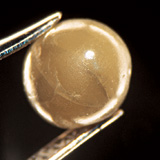 |
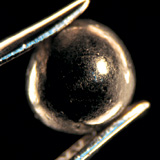 |
|
Photo.2:
|
Diamonds for high temperature (HT)-treatment.
|
|
Photo.3:Before and after the HT treatment. |
These high temperature (HT)-treated gblackh diamonds will effectively be distinguished by careful magnification test using a gemmological microscope. Needle-like black inclusions are identifying feature of natural black diamond (Photo-4 and 5).
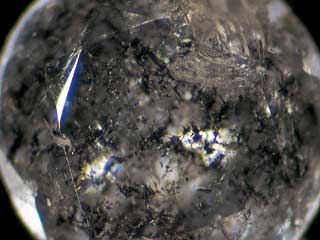 |
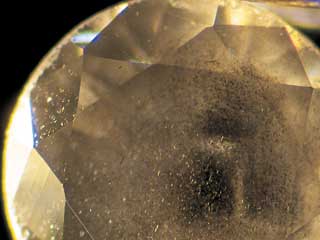 |
| Photo.4and5:Needle-like black inclusion in natural black diamond. |
Black inclusions in irregular shape are scattered inside a natural black diamond (Photo-6, 7and 8),
 |
| Photo.6,7and8:Irregular shaped black inclusion in natural black diamond. |
whereas they tend to be concentrated near surface or in surface-reaching fracture of faceted heat-treated gblackh diamonds (Photo-9, 10, 11 and 12).
 |
|
Photo.9,10,11and12:
|
Black inclusion concentrated in the surface area or in surface- reaching fractures in heat-treated gblackh diamonds.
|
|
In adding to these visual inspections above, photoluminescence (PL) analysis is known to be effective to identify the high temperature (HT)-treated diamonds. A trace of high temperature treatment or a characteristic feature of unheated stone can be detected as a peak in PL under very low temperature similar to identification of HPHT treatment. |








